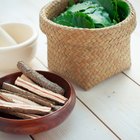
Tiger Balm, a Chinese ointment that was originally used primarily for muscular pain, can also be used for sinus problems, such as congestion and headaches. There are several Tiger Balm products. Some are better than others for this particular use. However, which Tiger Balm you use for this purpose will depend on your individual preference.
History
The Tiger Balm products are based on an ancient Chinese herbal recipe that was brought out of China more than 100 years ago by herbalist Aw Chu Kin. It was later further modified and developed by him, as well as his two sons, who used their names to create the company name, Haw Par Limited. Although it is no longer in the hands of the family, the name remains the same.
Formulation
The main products sold by the company are still the ointments. These can be found in white, red and soft varieties. The basic active ingredients of Tiger Balm are camphor, menthol, cajuput (or tea tree) oil and clove oil. They are are added in varying amounts, depending on the product. The white and red ointments also include dementholized mint oil, and the red adds cinnamon oil. Soft Tiger Balm includes neither mint nor cinnamon, but it adds a lavender fragrance.
Products
The red Tiger Balm ointment contains a higher percentage of menthol and cloves. This, with the addition of cinnamon, makes for a balm that is hotter. The white contains a higher percentage of cajuput and mint oils, which makes for a cooler balm. The soft has less than half the camphor of either the red or the white and more menthol than either. The result is an ointment that is gentler than the other two. There is also a product called Tiger Balm Refresher that comes in a small bottle with a roller ball applicator, making it perfect for travel.
Sinus Relief
These ointments can be rubbed on the sinus points of the head and face to relieve sinus headaches. They can also be dabbed on the inside of the nostrils to help to open up sinus congestion. Particularly for use within the nostrils, it is best to use either the white or the soft variations as the red, being hotter, is more likely to irritate the mucous membranes. Because the skin of the face can be more sensitive than other places on the body, it is also more likely to be irritated by the red formulation.
Cautions
Although the red ointment is hotter and more likely to irritate the skin, the white can do so as well. In particular, people with sensitive skin can experience an allergic reaction. Therefore, it is recommended to first test it on a small area before using the balm as directed.
Related Articles

Uses for Selsun Blue

The Best Cooling Lotion or Gel for ...

How to Heal an Inflamed Bikini Area

The Uses of Alcolado Glacial

Aloe Vera & Seborrheic Dermatitis

How to Get Rid of All the Tiny Embedded ...

Help for Red Marks After Facials

Can Bag Balm Help Acne?

What Is Aloe Good For?

Does It Help to Treat a Scar With Honey ...

Neem Bark Benefits

Remedy for Scratches in Leather

Petrolatum and Acne

The Best Idebenone Wrinkle Creams

How to Deal With a Chapped Nose From ...

Ingredients of Accutane

How to Get Rid of the Red on Your Face ...

The Best Ways to Get Dead Skin Off of ...

Uses of Pine Tar Ointment

Ingredients in StriVectin SD
References
Writer Bio
Maureen Santucci has been writing since 1989 in a variety of professions, including television syndication, where her bylines appeared in "TV Guide." Recent writings have been more focused on business and medicine and have appeared in various online publications. She has a bachelor's in history from UMass, a master's in business from UCLA and a master's in Oriental medicine from Emperor's College.
Photo Credits
headache face image by Julia Britvich from Fotolia.com